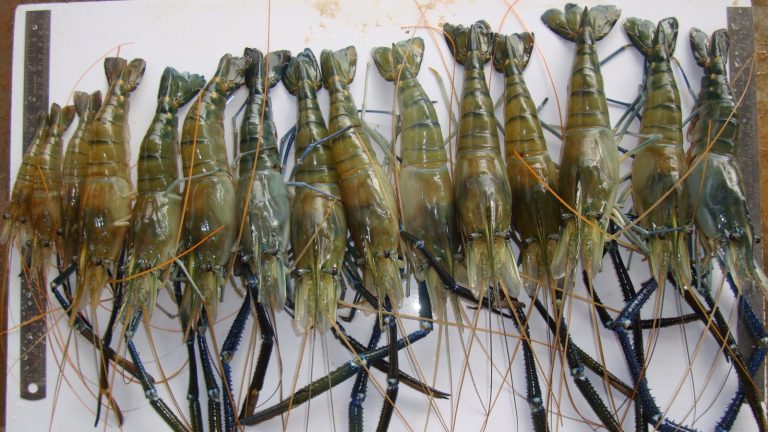
The Future of Prawn Farming Is Female
The Future of Prawn Farming Is Female
May 11, 2020
Ars Technica — BGU alumnus Dr. Assaf Shechter and Prof. Amir Sagi of BGU’s National Institute for Biotechnology in the Negev, cofounded Enzootic, an Israeli agro-biotech company.
The company has recently developed and commercialized a one-time, non-chemical, non-genetic gender-bending treatment that allows freshwater hatcheries to produce crops of all-female prawns.
Single-sex populations offer several advantages. For example, all-female freshwater prawn populations are very uniform in size and less aggressive, making it feasible to raise them in the more densely packed environments needed to make indoor aquaculture profitable.

Giant freshwater prawns have been a beloved delicacy throughout Southeast Asia, but, until recently, their need for a tropical environment has limited their cultivation in most other parts of the world.
Dr. Shechter says that this and several other developments make it possible to raise freshwater prawns in highly productive commercial aquaculture systems that are far less polluting and require less space, energy, and water than today’s operations.
While it is possible to hand-sort prawns for gender, the process is time-consuming and can only be done so far down the production cycle that it’s not really practical.
Enzootic’s gender-bending process solves that problem by going upstream to the breeding process and making alterations in breeding females that cause them to produce broods of single-sex all-female offspring.
The prawns used in this process determine their sex in a manner somewhat analogous to how it works in humans: there’s a chromosomal signal (think X/Y chromosomes) that is interpreted by an organ that makes hormones that control male and female development. But, unlike in humans, the mother can also influence the sexual development of the next generation.
The process takes advantage of these features. It starts by surgically extracting the hormone-producing organ from “donor” males, which are then broken down into individual cells. When the cells are injected into young females, the hormones they produce cause the females to develop as males, despite their chromosomes.
Just like natural male prawns, they can mate normally with other females, but some of their offspring possess a unique trait. Known as “super females,” they produce offspring that will develop as females regardless of the chromosomes they carry.
Enzootic has set up the genetics of its shrimp so that these super females are relatively easy to identify, and they can be used to quickly produce large populations of nothing but females. “Our goal was to take advantage of this natural and remarkable sexual plasticity to accomplish production of all-female populations without any kind of genetic modifications,” says Dr. Shechter.
The “All Boys” Prawn Club
Prof. Amir Sagi used many of the same insights on the factors that control sex differentiation of prawns to create breeder prawns capable of producing only male offspring, a process that dramatically boosts the productivity of outdoor aquaculture operations.
The absence of female prawns in outdoor ponds eliminates competition between males for mates that would normally result in injuries, deaths, and slower growth rates. Taking away the stimulus for aggressive behavior also reduces stress, allowing the prawns to direct even more of the calories they receive into growth.
This can improve production by as much as 45 percent which, when combined with the Asian market’s strong preference for the large prawns, could mean a 50- to 60-percent bump in a prawn farmer’s income.
A Vision for Sustainable Prawn Farming
Prof. Sagi and Dr. Shechter say that giving aquaculturists a reliable way to produce crops of single-sex prawns will improve the efficiency and profitability for both traditional (extensive) and high-tech (intensive) operations.
They are also hopeful that their freshwater cultivation techniques will provide an alternative for prawn and shrimp farmers seeking to reduce the environmental impact of pond- and ocean-based crustacean aquaculture operations. For example, the cultivation of saltwater shrimp has drawn strong criticism because many production facilities in Asia and Southeast Asia are created by destroying vast stands of mangrove swamps, which are vital parts of the marine ecosystem.
Any aquaculture operation requires some amount of water exchange to keep the system healthy, but the small amount of the freshwater discharged from a prawn farm each day can be used to irrigate crops. That’s a serious bonus in sun-rich but water-starved areas such as Israel’s Negev, as well as many parts of Africa and America’s Southwest.
Enzootic is wagering that these types of intensive indoor systems are the future of fish, shrimp, and prawn production and that the higher stocking densities made possible by their all-female breeding technology will help accelerate their adoption.
To prove their point, Enzootic is building an indoor aquaculture facility located near Beer-Sheva. The demonstration farm’s recirculating system only needs to exchange one percent of its tanks’ capacity to keep the water and micro-ecosystem clean, balanced, and free of toxins.
What’s more, the exchange water, pulled from the tanks and bio-filtration system, is rich in natural fertilizers that can be used to irrigate and feed conventional or hydroponic food crops.
“Since these are indoor farms, we have much better control over the water quality, and we have no need to use antibiotics, chemicals, or fertilizers,” says Dr. Shechter.
Beyond the consumer applications, Prof. Sagi has also been involved in research on using the prawns to combat schistosomiasis, a debilitating waterborne disease that affects around 200 million people worldwide, primarily in impoverished areas.




